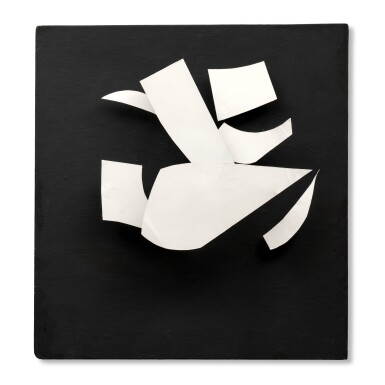Swiss Fine Art
Swiss Fine Art

Property from an Important Private Collection
Jean Tinguely
Blanc sur Noir
Lot Closed
December 12, 01:51 PM GMT
Estimate
260,000 - 350,000 CHF
Lot Details
Description
Property from an Important Private Collection
Jean Tinguely
1925 - 1991
Blanc sur Noir
wood and metal on panel; wood pully, rubber belt, metal fixtures & electric motor on the reverse
58 by 62cm.
22¾ by 24⅜in.
Executed in 1959.
Galerie Denise René, Paris
Acquired from the above by the present owner
Christina Bischofberger, Jean Tinguely, Catalogue Raisonné, Sculptures and Reliefs 1954-1968, Zurich & New York, 1982, vol. I, no. 134, p. 107, illustrated
Tel Aviv, Musée de Tel Aviv, Art et Mouvement: Art Optique et Cinétique, 1965
Paris, Galerie Denise René, Le Mouvement 1955-1975, 1975, p. 37, illustrated
“Everything moves. Immobility does not exist. Do not be dominated by antiquated notions of time. Forget hours, minutes, seconds. Don’t resist metamorphosis. Live in time…”
Jean Tinguely, Exh. Cat., Venice, Palazzo Grassi, Jean Tinguely 1954-1987, 1987, p. 56.
Jean Tinguely’s uniquely experimental approach to sculpture is unparalleled, embodying an innovative fusion of aesthetics and mechanics that posed revolutionary new dimensions for the status of the artwork. Known for his kinetic sculptures and installations, Tinguely’s artworks are constructed from everyday materials such as metal, wood and different motors, and explored themes such as movement, machinery and chance, creating a unique experience for the viewer. Blanc sur Noir is a prime example of the monochromatic yet humorous kinetic sculptures which Tinguely created in the 1950s. Today other examples from this series can be found in the Museum of Modern Art, New York, the Centre Georges Pompidou, Paris and the Moderna Museet, in Stockholm and Malmo.
In the early 1950s, Tinguely moved to Paris together with his wife Eva Aeppli. He started making use of scrap sheet metal found in the streets, cutting, painting and mounted them onto wooden boards. With the addition of tiny motors on the reverse he set each shape to rotate in slow circles, resulting in animated paintings through slowly changing compositions that set the Constructivist abstraction of the 1920s into endless motion. In 1954, Tinguely had his first solo exhibition at the Galerie Arnaud Lefebvre, where he exhibited relief works, similar to Blanc sur Noir, which resembled black boxes with geometric white shapes. Described by the Swedish art historian Pontus Hultén as “meta-mechanical”, Tinguely would with these works use mechanical means to move beyond the standard painting, creating works that would transform over time.
The curious inner workings of Tinguely’s visionary mechanical aptitude gave birth to a hypnotic tableau of transitory maneuvers. Utilising bold yet elegant white forms over a black background, which may otherwise misgive a sense of permanence, the piece assembles an animated dance that relishes in the ephemeral rhythms of abstract shape relations and chance encounters. In Blanc sur Noir, seven white irregular cut-out shapes seam to float over a black box, recalling the viewer of Jean Arp’s constellation relief woodcut forms. In addition to these formal similarities between the two artists, Tinguely further implemented Arp’s integration of chance and spontaneity as key elements of his process.
The use of concrete materials to convey a sense of weightless movement and motion provides a meditation on the poetics of automated systems; specifically man’s ability to create subsidiary animation and new life through the mechanical. Tinguely’s moving sculptures break down the paradoxical boundaries between artistic creation and the mechanically manufactured. Whereas the former is considered to be a distinctly human form of expression, the artist’s kinetic pieces leave part of the poetic manifestation of his work to the automated performance of his machines. As Tinguely noted, "the machine is an instrument that permits me to be poetic. If you enter into a game with the machine then perhaps you can make a truly joyous machine – by joyous, I mean free” (Jean Tinguely cited in: Calvin Tomkins, Ahead of the Game: Four Versions of the Avant Garde, Harmondsworth, 1968, p. 140).
